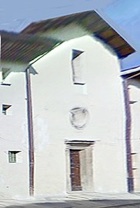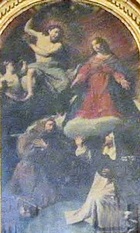

The following nunneries have their own pages in this website:
-
✴San Marziale and Santa Chiara (which merged in 1787);
-
✴Santo Spirito; and
Sant’ Antonio da Padova (???)
Poor Clares
[Early history ??]
The few remaining nuns from the Monastero di Sant’ Elisabetta (below) were transferred to this community in 1638, when their original nunnery passed to the Episcopal Seminary.
An inscription over the entrance to the church records its rebuilding in 1733.
[When did the Poor Clares leave the nunnery ??]
Dominican Nuns from San Biagio
In 1601, Bishop Andrea Sorbolonghi gave the Convento di San Biagio to a group of 14 female penitents. He put them under the supervision of two Dominican nuns from Perugia.
As noted above, this community moved to the current site in 1786. The community was suppressed for a period in 1808 and then again in 1860, but was re-established in 1880.
Church
As noted above, the church was rebuilt in 1733.
Altarpiece (1576-9)
This documented altarpiece by Virgilio Nucci and its frame, which is attributed to Antonio Maffei, no longer survive. The altarpiece apparently depicted:
-
✴the Adoration of the Magi; and
-
✴the Visitation and the Annunciation above.
Crucifixion with St Mary Magdalene (1610)
This altarpiece [by/attributed to Virgilio Nucci and dated by inscription] is in the sacristy.
Madonna and Child with St Antony of Padua (18th century)
This altarpiece on the high altar was documented with an attribution to the Bolognese school in 1768 and again, by Luigi Bonfatti, in the middle of the 19th century, with an attribution to “Gaetano da Bologna” (possibly Gaetano Gandolfi). The damaged panel survives in the nunnery.
Immaculate Virgin with saints (18th century)
This altarpiece on the altar of the chapel on the the right depicts the Virgin seated on a cloud, with SS Bonaventure and Bernardino of Siena below. It was documented in 1768 with an attribution to Giovanni Francesco Ferri da Pergola.
St Dominic (date ?)
This altarpiece on the altar of the chapel on the the left was placed here by the Dominican nuns when they moved to the nunnery. It replaced an altarpiece (18th century) of SS Peter of Alcantara, Diego of Alcalá and Rose of Viterbo that was documented in 1768 with an attribution to Giovanni Francesco Ferri da Pergola.
Monastero del Buon Gesù (late 16th century)
A group of pious women that included a widow, Piera Rubeni acquired the complex in 1561. They had previously faced a number of difficulties in executing their plan to establish a nunnery affiliated to the new Capuchin Order, but managed to secure these premises with the help of Duke Guidobaldo II and the city authorities. In 1567, some 30 members of the community took their vows before Bishop Mariano Savelli. (The new female order of Capuchins had only been established (in Naples) in 1538, and this community in Gubbio is one of the oldest in Italy).
The church is still open for Mass. The nunnery is known alternatively as the Monastero delle Cappuccine.
Nuns’ Church
Deposition (1585)
This panel on the high altar is [signed by Felice Damiani and dated by inscription ??]
Immaculate Conception (1596)
This panel, [which is dated by inscription ??], is alternatively attributed to Virgilio Nucci or Federico Brunori.
Nunnery
Holy Family with St Catherine (1583)
This panel in the nunnery is signed by Benedetto Nucci and dated by inscription. It is a copy of a panel (1533) by Lorenzo Lotto that is now in the Accademia Carrara, Bergamo.
St Catherine of Alexandria (ca. 1610)
This panel in the nunnery is attributed to Virgilio Nucci.
[Madonna and Child, attributed to Ottaviano Nelli ??]
Sant’ Elisabetta (date)
[Early history ?]
The few remaining nuns from this nunnery moved to Sant’ Antonio da Padova (above) in 1638, when their original nunnery passed to the Episcopal Seminary.
Santa Lucia (1530 ?)

In 1530, the nuns took advice on an appropriate location for a new church and dormitory that was to be built by three Lombard masons, the Maestri Matteo, Quirico and Pietro. (One of the people consulted was Mariotto di Paolo Sensi, il Terzuolo).
The four remaining nuns at Santo Spirito moved here in 1905 when their nunnery was closed.
The complex now houses the "Casa Famiglia Santa Lucia", an orphanage administered by a community of Dominican tertiaries that was established here in 1918.
[St Lucy in Glory (ca. 1675)
This fresco in the ceiling is by/attributed to Francesco Allegrini. ]
Intercession of the Virgin (ca. 1695)

St Lucy in Glory (18th century)
This panel on the 1st altar on the left is attributed to Gaetano Lapis.
Return to Monuments of Gubbio.
Return to Walk I (except the Monastero del Buon Gesù and Santa Lucia) or
Walk II (the Monastero del Buon Gesù and Santa Lucia)


